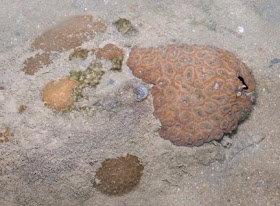Back again to survey oil-slicked Tanah Merah, today doing the stretch near the Ferry Terminal. A night trip usually means more fishy sightings and I wasn't disappointed.
I had a glimpse of this large colourful fish, which I'm guessing is some kind of grouper?
I also saw a cuttlefish (Family Sepiidae) today!
Today, there were lots of Chocolate hind (Cephalopolis boenak) on the shore. Also many Bengal sergeants (Abudefduf bengalensis).
Often, when I see this fish, I notice the eye looks injured. Is it really injured or do the eyeballs to that naturally? So much more to learn about our shores!
Stonefish is a real danger on this shore and today I only spotted one. But the Hollow-cheeked stonefish (Synanceia horrida) is so well camouflaged, there are probably others that I didn't see.
As with my last trip here in April 2012, filefishes (Family Monacanthidae) were abundant, although they are very well camouflaged.
Other fishes seen include: various cardinalfishes (Family Apogonidae) and the Black cardinalfish (Apogon melas), White spotted rabbitfishes (Siganus canaliculatus), halfbeaks (Family Hemiramphidae).There were also many damselfishes (Family Pomacentridae), Painted scorpionfishes (Parascorpaena picta), lots of gobies (Family Gobiidae) of all kinds.
There are also many small to medium coral colonies growing on the artificial seawall here. With lots of fishes and crabs tucked among the rocks too.
My first sighting on this shore, what looks like a very young Tongue mushroom coral (Herpolitha limax)!
Other special corals seen include: Anemone corals (Goniopora sp.), Circular mushroom corals (Family Fungiidae) and small Disk coral (Turbinaria sp.).
As usual, the most common kind of coral were Favid corals (Family Faviidae) in all colours and patterns.
I saw many corals that were rather orange. I'm not sure if this is something to worry about.
Many different kinds of corals were this same orangey colour.
There were many Pore corals (Porites sp.), which formed the largest colonies on this shore. Most were not bleaching although some had dead portions and others were rather orange.
I saw a few coral colonies that were bleaching.
There are many large and juicy looking patches of Button zoanthids or colonial anemones (Zoanthus sp.).
I saw one Swimming anemone (Boloceroides mcmurrichi) and several Frilly sea anemones (Phymanthus sp.).
I saw several Stone crabs (Myomenippe hardwickii) and Red egg crabs (Atergatis integerrimus). Also one Velcro crab (Camposcia retusa) and the Sea toad spider crab (Scizophrys sp.). As usual, there were many small Swimming crabs (Family Portunidae) and some Spotted moon crabs (Ashtoret lunaris).
The tiny Spoon seagrass (Halophila ovalis) which I first noticed in Apr 2012 is still there, covering quite a large area. The Spoon seagrasses disappeared even before the oil spill, so it's good to see them back.
The patch of Sickle seagrass (Thalassia hemprichii) is also growing larger and seem to be doing alright. The blades are no longer 'chomped' at the tips.
I saw three clumps of Tape seagrass (Enhalus acoroides) and they seem ok, although the leaf tips are still burnt.
The two patches of Smooth ribbon seagrass (Cymodocea rotundata) have grown enormously. Both have reached the rock wall. The patches are still studded with small Haddon's carpet anemones (Stichodactyla haddoni). Sadly, also litter. I couldn't find any anemone shrimps today.
Among the seagrass blades, tiny fishes that look like seagrasses too. There are five fishes in this photo, can you spot them?
Among the seagrasses, a small Pink moon snail (Natica zonalis), and lots and lots of Dubious nerite (Clithon oualaniensis) crawling on the leaf blades.
There were small clumps of seaweeds of different kinds. But there is generally little seaweed growth, as usual.
Today I didn't see any Common sea stars (Archaster typicus), but it's hard to spot them during a night trip, especially alone. Also no landscape photos as the trip ended before sunrise.
Scum still forms on much of the water surface, more obvious near the rocks with the outgoing tide.
Another view of the scummy water surface with a fan worm.
The sand is relatively clean, although blackish portions are still widespread.
More about the oil spill on this blog and on the Oil spill facebook page.
This shore is where we saw this Siemens water project during a trip a few weeks ago.
The project had pipes lead out across the seawall, discharging onto the reefs and seagrasses in the area.
I wrote to Siemens after the trip, and yesterday, I got a reply from them. Here's their explanation of the project and my additional questions to their reply.





























